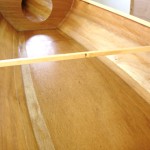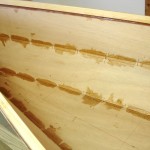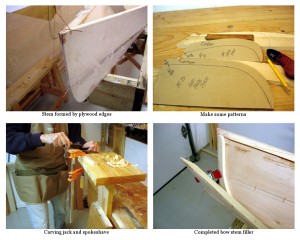 These folks look experienced with the glue part of stitch-n-glue boatbuilding.
These folks look experienced with the glue part of stitch-n-glue boatbuilding.
It’s time to fully fill the seams with thickened epoxy and add fiberglass tape for strength. As an aside, the “tape” is simply fiberglass fabric that is 4 inches wide, finished on each edge to avoid fraying. Filling the seams is the same as I did with “tabbing” in the previous post, spreading thickened epoxy with a rounded stick about 1 inch wide. Affixing the tape is with unthickened epoxy, regular stuff that’s slightly less viscous than molasses. CLC’s instructions suggest painting on a coat of epoxy, pressing the cloth in place, and then painting on more epoxy to saturate the cloth. Another fellow I read suggests soaking the cloth strip in epoxy to saturate it, then placing it in the boat and spreading out the excess with a gloved hand.
 I tried both ways, always with gloves. Both methods work, but one feels like you’re retrieving your waffle from a vat of syrup chocolate.
I tried both ways, always with gloves. Both methods work, but one feels like you’re retrieving your waffle from a vat of syrup chocolate.
The interior of this boat will get no more fiberglass. A few people glass both the exterior and interior of their boats. I think those are the people who don’t mind the extra weight and want the extra strength for extreme canoeing adventures. This boat will get two very thin coats of epoxy as a sealer. Another finish will be added later for UV protection (epoxy has very little). The first coat is on, applied with a short nap foam roller which really spreads the epoxy thin, helping minimize weight.

